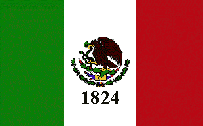The next reference to an 1824 Flag can be found in the proceedings of the General Council of the Provisional Government of Texas. I believe that from the Dimmit design, evolved the design that was adopted by this General Council for the banner which was to be flown by ships bearing "Letters of Marque and Reprisal". These were privately owned and operated ships that were granted permission by the government to attack and seize enemy ships and cargo. In return for this license the government received a percentage of the value of the seized property. On November 29, 1835 the General Council passed an ordinance which reads in part:
"...Sec. 2. Be it further ordained and decreed, &c., That all vessels sailing under Licenses, as Letters of Marque and Reprisal, which have been, or may be hereafter granted by the Governor and Council, or by the Governor, as provided in this supplementary Ordinance, or under any register or license of this Government, shall carry the flag of the Republic of the United States of Mexico, and shall have the figures 1, 8, 2, 4, cyphered in large Arabics on the white ground thereof....Passed at San Felipe de Austin, Nov. 29, 1835."

According to this description, there are several designs possible for the privateer flag. The description does not specifically eliminate the eagle motif from the Mexican flag and according to the description, the numerals could have been placed above or below the eagle or could have replaced the eagle altogether. It is very clear that early in the Revolution there were several possible designs for an ensign that signified the desire to restore the Mexican Constitution of 1824, however no original examples of these banners exist today.
